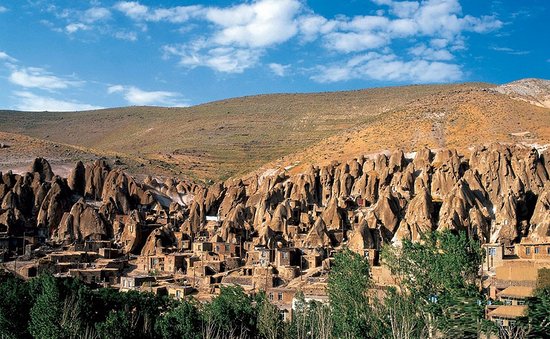Tucked away in the northwest corner of Iran is the quaint and mysterious thirteenth century village of Kandovan. It’s a village in Sahand Rural District, in the Central District of Osku County, East Azerbaijan Province, Iran. Kandovan is also part of the Lake Urmia region, the region that is central to the start of the second phase of Zoroastrian history. This village consists of manmade cliff dwellings which are still inhabited. The troglodyte homes, excavated inside volcanic rocks and tuffs similar to dwellings in the Turkish region of Cappadocia, are locally called “Karaan”. Karaans were cut into the Lahars (volcanic mudflow or debris flow) of Mount Sahand. The cone form of the houses is the result of lahar flow consisting of porous round and angular pumice together with other volcanic particles that were positioned in a grey acidic matrix. All these aspects, make the landscape look like a gigantic termite colony. This method of dwelling makes the residents modern-age cave dwellers or troglodytes. After the eruption of Sahand these materials were naturally moved and formed the rocks of Kandovan. iran tour
When you first come upon the houses, you might not notice them, as the stone used to expand the dwellings outside of the caves, mimics that natural color of the original stone. But once you get closer to the village, you can see the windows, power wires, doors, and chimneys jutting out of the rock face. Most communities have become modernized, with power and some even with running water, all while blending perfectly into the natural surroundings. The volcanic stone is both easy to manipulate and sturdy enough to support these ancient constructions.
What is particularly amazing about these homes is that they have supported life for centuries. They are ancient cave dwellings. The first inhabitants were from ancient tribes, but these homes have been updated and passed down from inhabitant to inhabitant.
Most communities have taken special precaution to preserve as much of the original cave as possible, so that both the exterior and the interior have that authentic Kandovan feel. Some houses rely on the natural cave formations, while others have been hollowed out into larger rooms, and have even been whitewashed to create a more modern look and feel.
Most of the cave houses are two to four storeys in height. In a typical four storey house, the ground or first floor is used as an animal shelter, the next two floors are used as living areas, and the top floor is used for storage. There are reports of tunnels connecting towers owned by a person or family.
While Mount Sahand itself is one of the beauties of the region, the surrounding country abounds in a natural beauty that is today but a shadow of a legendary past. Some believe that legendary past beauty is preserved in the biblical story of the Garden of Eden. Ancient Persian gardens, also called baghs, were renowned for their spectacular beauty.
The houses are known as karan in the local dialect. One interpretation has the word Kandovan being a plural form of kando, a bee’s hive. Another interpretation says that Kandovan means Land of Unknown Carvers. The use of ‘van’ to indicate the plural is found in the Avesta: cf. ashavan. Nowadays, residents speak a Turkic dialect but have traditional Iranian family names, names such as Kayani. The mountains and rivers in the region have both Persian and Turkic – and perhaps even Assyrian – names.
Kandovan Village
December 20, 2021
0 comment

Comment (0)